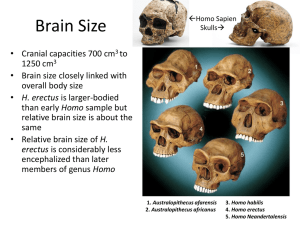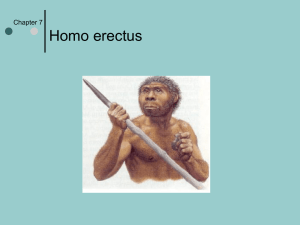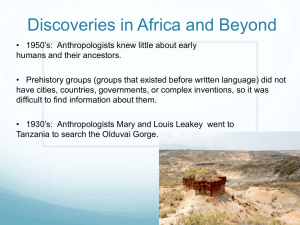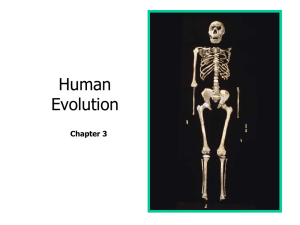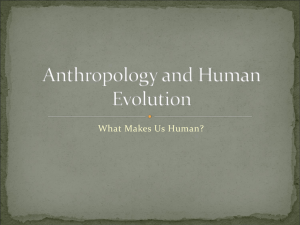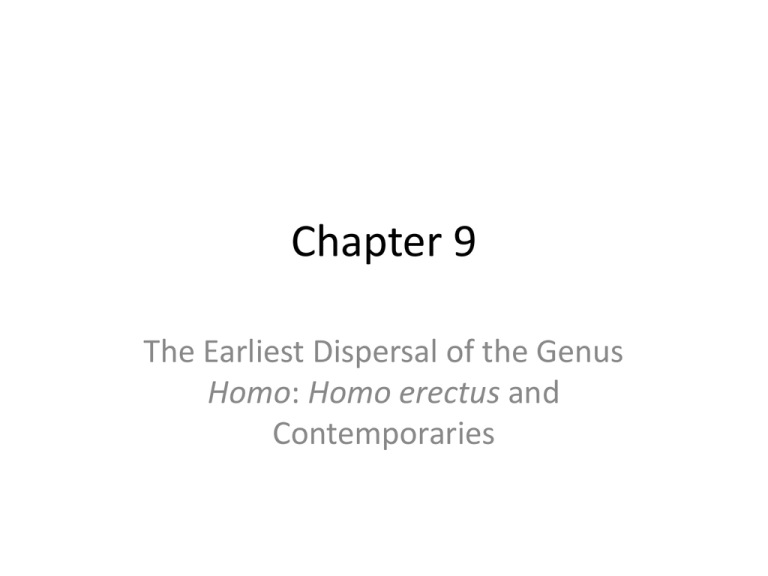
Chapter 9
The Earliest Dispersal of the Genus
Homo: Homo erectus and
Contemporaries
Left: Homo Erectus (1mya)
Center: Australopithicus afarensis (2.5mya)
Right: Homo Neandertalensis (100,000-32,000ya)
Homo erectus
• Discoveries from East Africa have established Homo
erectus by 1.8 m.y.a.
• Some researchers see anatomical differences
between the African and Asian discoveries.
– They place African fossils into the Homo ergaster
species.
• Analyses show that H. erectus/ergaster represents
closely related species and possibly geographical
varieties of a single species
BECOMING HUMAN PART II
• NOVA
First Dispersal of the Hominins
• Close to 2 million years ago, hominins
expanded out of Africa into other areas of the
Old World.
• Since the early hominin fossils have been
found only in Africa, it seems that hominins
were restricted to this continent for as long as
5 million years.
First Dispersal of the Hominins
• After 2 mya, there’s less diversity in these
hominins than in their pre-australopith and
australopith predecessors.
• There is universal agreement that the
hominins found outside of Africa are members
of genus Homo.
• Homo erectus is the species for which there is
the most evidence.
Homo erectus – A New Kind of
Hominin
• The first hominin to expand into new regions
of the Old World.
• As a species, H. erectus existed over 1 million
years.
• We can understand its success as a hominid
species based on behavioral capacities (i.e.)
more elaborate tool use) and physical changes
(i.e. larger).
Grade
• H.erectus hominins represent a different grade of evolution
than their African predecessors.
• Grade refers to a grouping of organisms sharing a similar
adaptive pattern.
• Grade implies nothing directly about shared ancestry, but
implies general adaptive aspects of a group of animals
Morphology of Homo erectus
• Living in different environments over much of
the Old World, H. erectus populations shared
several common physical traits including…
Body Size
• Adult weight >100 lbs,
average adult height of
ca. 5 feet 6 inches
• Sexually dimorphic,
weight and height
varied according to sex
• Increased robusticity
(heavily built body)
that dominated
hominin evolution
until anatomically
modern H. sapiens
Homo Sapien
Skulls
Brain Size
• Cranial capacities 700 cm3 to
1250 cm3
• Brain size closely linked with
overall body size
• H. erectus is larger-bodied
than early Homo sample but
relative brain size is about the
same
• Relative brain size of H.
erectus is considerably less
encephalized than later
members of genus Homo
1. Australopithecus afarensis
2. Australopithecus africanus
3. Homo habilis
4. Homo erectus
5. Homo Neandertalensis
Cranial Shape
• Thick cranial bone, large
browridges (supraorbital tori), and
projecting nuchal torus
• Braincase long and low, with little
forehead development
• Cranium wider at base, compared
with earlier and later species
• Sagittal keel, a small ridge from
front to back along the sagittal
suture, reflects bone buttressing
in a very robust skull, rather than
a specific function
Homo Erectus finds
Africa, Asia, Indonesia, Europe
Homo erectus from Africa
•
Homo erectus evolved first in Africa, supported by
evidence of:
1. Earlier hominins prior to the appearance of H.
erectus occurring in Africa.
2. 1.8 mya fossils at East Turkana, in Kenya, and
not long after at other sites in East Africa.
3. Though, 1.75 mya populations in southeastern
Europe; 1.6 mya populations in Indonesia,
suggesting quick migrations
TURKANA BOY
a.k.a. Nariokotome Skeleton WT
15000
• In 1984, Kamoya Kimeu
discovered a small piece of
skull on the west side of Lake
Turkana at the site known as
Nariokotome.
• The excavations produced
the most complete H. erectus
skeleton ever found
• Facial bones, a pelvis, and
most of the limb bones, ribs,
and vertebrae.
TURKANA BOY
Nariokotome Skeleton
• The Nariokotome
skeleton is dated to
about 1.6 mya.
• The skeleton is that of a
boy about 12 years of
age with an estimated
height of 5 feet 3
inches.
Olduvai Gorge
• Find by Louis Leakey in 1960,
includes well-preserved cranial
vault with small part of upper face.
• Dated at 1.4 mya, the cranial
capacity is the largest of all the
African H. erectus specimens.
• The browridge is the largest known
for any hominin, but the walls of
the braincase are thin.
– Similar to East African H.
erectus specimens; differs
from thick cranial bones in
Asian H. erectus.
Gona Evidence
• Ethiopia find dated to appx. 1.3 mya
• Female pelvis with very wide birth canal, indicating large-brained infants
in utero
• Perhaps newborn H. erectus with a brain that was comparable to typical
modern human baby
• Suggests, when compared with Nariokotome pelvis, considerable sexual
dimorphism in skeletal anatomy is linked to reproduction and body size
Daka Evidence
• Middle Awash of
Ethiopia find dated to
appx. 1 mya
• Complete cranium
more like Asian H.
erectus than most
earlier East African
remains discussed
• Discounts argument
that East African fossils
are different species
than Asian H. erectus
The Earliest African Emigrants
• Why they left is a mystery
• A greater range of physical variation in
specimens outside of Africa at about 1.8 mya
• Into Java, Indonesia by 1.6 mya
• Equates to less than 200,000 years to travel
from East Africa to Southeast Asia
The Dmanisi Hominins
•
•
•
The discovery of the Dmanisi materials in the Republic of Georgia began in the early 1990s.
The most informative specimens are four well-preserved crania, with one recently discovered
being almost complete.
The remains are the best-preserved hominins of this age found anywhere outside of Africa.
The Dmanisi Hominins
• The most complete specimen has
a less robust and thinner
browridge, a projecting lower
face, and a large upper canine.
• All three Dmanisi crania have
small cranial capacities.
• A number of stone tools, similar to
Olduwan industry from Africa,
have been recovered at Dmanisi.
• Remains from four individuals
allows comparisons with H.
erectus from other areas
Dmanisi Diagnostic Characteristics
• Estimated height ranging from ca 4 feet 9
inches to 5 feet 5 inches, smaller than full H.
erectus specimens from East Africa or Asia
• Body proportions, however, similar to H.
erectus (and H. sapiens) and different from
earlier hominins


